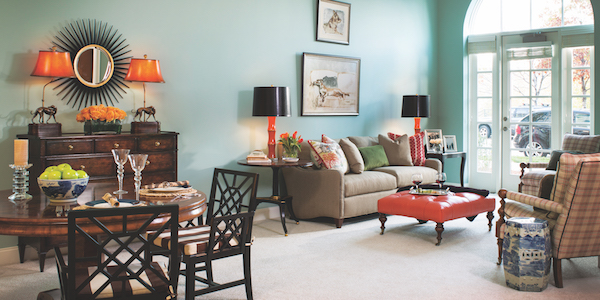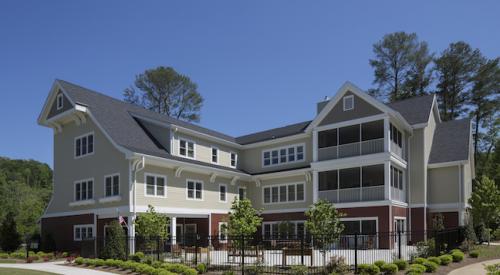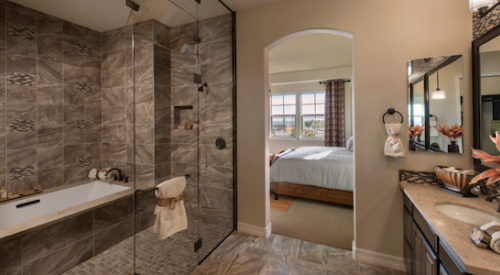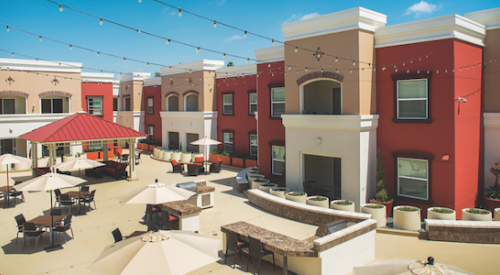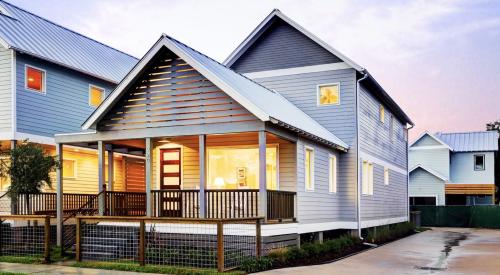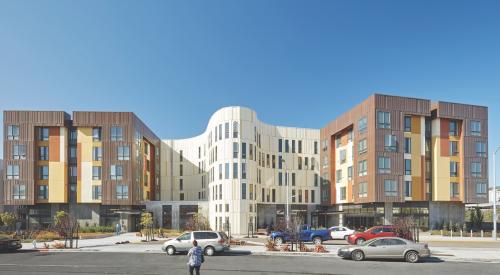A curious thing happened when builders started designing houses, communities, and advanced-care residences to court the gigantic wave of older homebuyers: They ended up creating homes that live better for young, old, and everybody in between. Open floor plans with wider doorways and flat or slightly sloped garage entrances into the house may be prescribed for older homebuyers, but they’re just as handy for baby strollers, grocery toting, furniture moving, and getting through the door after you break a leg skiing.
The same is true of bathrooms with roomy zero-edge showers equipped with grab bars as sleek as they are helpful—practical for less-than-sure-footed users, whether they’re toddlers at 2, pregnant at 32, or wobbly at 92.
Big strides
A decade ago builders fretted over building homes for older buyers. They wanted houses that would accommodate inhabitants as they aged, but worried that the sight of a grab bar by a toilet or in a shower would turn off Boomer buyers—famously in denial about being less than healthy and mobile—by reminding them of their mortality.
Architects and designers found some answers, making these accommodations vanish into high design. An example of how seamlessly accommodations for aging can be incorporated into new homes is the award-winning Victory at Verrado, an age-qualified development by DMB Associates outside of Phoenix within the Verrado master plan—arguably a poster child for how to build for an aging population. The homes won multiple awards in the NAHB’s 2016 Best of 55+ Housing Awards. Rather than hide them, the developer promotes the Universal Design elements that are knit into the fabric of the homes, including showy showers, easy-reach cabinets and appliances, and variable kitchen counter heights for sitting or standing.
It took a long time for these changes to occur, especially in bathrooms, which are critical spaces for aging-in-place design. Mary Jo Peterson, a Connecticut-based aging-in-place specialist and certified kitchen and bath designer, worked with architect Manny Gonzalez, of KTGY Architecture + Planning, in Los Angeles, on Verrado’s age-friendly bath designs. The big glass showers are luxurious and spa-like; large enough for anybody to easily use, with zero-threshold entries that further eliminate boundaries. “I’ve been trying to get builders to do that for the last 20 years,” Peterson says. And she’s now taking on design features that are barriers for some. For example, in a small powder room with a toilet, Peterson suggests that builders make sure there is an adjacent area, perhaps a linen closet, that can later allow for expansion of the space, if needed.
Universal, or just good design?
Homes incorporating Universal Design principles have become much more common in 55-plus communities, says Dr. Margaret Wylde, CEO of ProMatura Group, a consumer research firm based in Oxford, Miss. Wylde eschews the Universal Design label, simply describing it as “damn good design.” And she’s finding sensible design for aging showing up more in her practice these days. “Developers today are building very livable homes,” she says. “Many are single-story and low-maintenance in neighborhoods with a good sense of camaraderie.”
Balfour at Riverfront Park in Denver is a continuing-care retirement community (CCRC) that more closely resembles a high-end hotel in its design, finishes, and amenities. (Photo: Kimberly Gavin)
Integration vs. isolation
As Universal Design in age-qualified communities makes homes more livable for the long-term, the decision about where to put age-qualified communities within master plans is also undergoing a big change.
Rather than the old model of creating islands of gated, age-restricted housing out in the suburbs (the thinking being that older buyers want isolation from other age groups), developers are rethinking that model, integrating age-qualified communities within all-age developments, siting in or near town centers, and giving residents easy walking access to shops, restaurants, and grocery stores.
“We have found that older homebuyers don’t necessarily want a completely segregated everything,” says Wylde. As an example, “You don’t have to have two fitness centers [in a master plan], one for the older buyers and the other one for everybody else,” she says. “One center with a good spectrum of equipment will do.”
The amenity that age-qualified communities aren’t willing to share is their pool. Kids’ cannonballs, it seems, are a disruption to poolside peace for older residents. But that doesn’t mean they don’t want access to the development’s all-age pool, which comes in handy when the grandchildren visit, Wylde says. CalAtlantic Homes also offers an integrated active-adult community called Gavilán that’s woven into its Rancho Mission Viejo, Calif., neighborhoods.

Walking into Balfour at Riverfront Park, in Denver, feels more like stepping into a country club than an age-restricted community. Yet it serves a variety of residents’ needs, from independent living to assisted living and Alzheimer’s and memory care. It was Best of 55+ Continuing Care Retirement Community for 2016. Developer: Balfour Senior Living (Photo: Kimberly Gavin_
Trading the golf cart for hiking shoes
The ability to walk to shopping, leisure activities, and places to exercise is a top desire for many new-home buyers, but it takes on extra importance for 55-plus buyers who may want to drive less or need to give up driving altogether. Riviera Walk at Riverstone, by Active West Builders, is another winner of several 55-plus awards and offers single-family detached homes close to downtown Coeur d’Alene, Idaho, where the builder is based. Residents can stroll to movies, shops, and restaurants and have private access to North Idaho’s Centennial Trail, which offers 24 miles of multiuse recreational land.
But walkable communities aren’t limited to single-family developments. Often it’s even easier to create them in urban areas where density has already provided sidewalks, mass transit, nearby shops, and entertainment—all that’s needed for a car-free life. But some builders of 55-plus homes have created suburban venues that allow for easy access to shopping.
Azulón at Mesa Verde apartments, which won NAHB’s Best of 55+ Housing Award for Market-Rate Rental Community, was built on a lot that was supposed to be the second phase of a shopping center. Instead, the market-rate apartment complex was built on the lot and a short paseo between the two was created, says Manny Gonzalez, its architect. “The No. 1 amenity demanded by the 55-plus market is proximity to a grocery store,” Gonzalez says. “It’s a killer as a sales point—theability to walk and get your groceries and know your butcher and produce people.” And a close population helps guarantee the shopping center’s success as well.
Light and warmth
As universal design has begun to transform single-family homes targeted for older buyers, ideas borrowed from high-end hospitality have begun to inform assisted and independent living developments, says Jerry McDevitt, principal and director of senior living at GGLO Design, in Seattle. The newest, best communities are a universe away from the dreaded nursing homes etched into the memories of Baby Boomers who agonized and often regretted relegating their loved ones to those places. “Many people live within elegant glass walls with good vistas now,” McDevitt says. One such example is Sagewood at Daybreak, in South Jordan, Utah, just outside of Salt Lake City, designed by GGLO Design in Seattle. It won both the Best of 55+ Independent Living Community award and the 55+ 2016 Community of the Year.
Flooded with natural light, Sagewood includes independent living, assisted living, and memory-care help. McDevitt says long, dark hallways are anathema in the newest designs, which have daylight available to all. Rather than a central area for all caregivers, small individual “household” units are clustered together, with caregivers dispersed among the units. Access to outdoor areas and gardens is a high priority, and individual units have doors that open to the outside—fresh outdoor air is welcomed—and indoor lights are LEDs with dimmers. Residents aren’t tied to one dining option; there are several, including quick-serve offerings for midnight snacking.
Balfour at Riverfront Park, in Denver, an NAHB Best of 55+ winner for a CCRC (continuing care retirement community), is nearly indistinguishable from a high-end hotel with its entry hall and spaces flooded with natural light. The public rooms are luxurious, with bright pops of color. Balfour provides independent living, assisted living, and Alzheimer’s and memory care. Balfour Senior Living developed the CCRC, and Klipp, a division of Irvine, Calif.-based multinational construction firm Gkkworks, designed it. Unfortunately, these appealing options are likely to be out of reach for many seniors because of cost.

Sagewood at Daybreak, NAHB’s Best of 55+ Housing Awards 2016 Community of the Year, in South Jordan, Utah, offers the appeal of a luxury hotel. Developer: Kisco Senior Living; Architects: GGLO Design and Beecher Walker Architects (Photo: Derek Reeves/Corey Middleton)
Affordable options are scarce
“Whether it’s rural or in the cities, my experience is that when you build something that’s affordable and senior, you are going to have no trouble leasing it up and there will be a waiting list,” says John Perfitt, executive director of nonprofit Restore Neighborhoods LA, a developer of affordable housing. Need further proof that it’s a pressing need for seniors? Take a look at the eight-year waiting list for an apartment at Angelus Plaza in downtown Los Angeles. With 1,100 units, it’s the largest age-qualified community in the country and within walking distance of mass transit, a farmers market, a park, grocery shopping, and the Walt Disney Concert Hall. “It used to be five years’ [wait],” says Niché Perry, a program assistant at Angelus Plaza. But because people are healthier and living longer, the shortage is only going to get worse, says Gonzalez, who has been working on renovating Angelus, “just because of the number of people who are getting older and are on a fixed income.”

Flooded with natural light, Sagewood includes independent living, assisted living, and memory-care help. (Photo: Derek Reeves/Corey Middleton)
